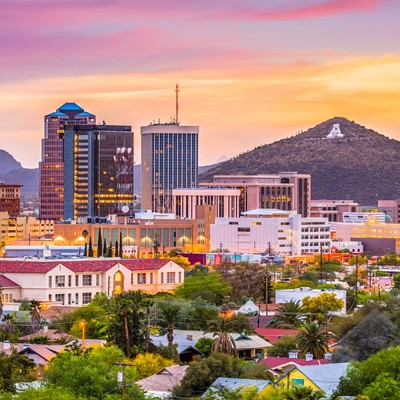Despite a growing list of private-sector success stories downtown, many central-city supporters don't want publicly financed incentives reduced.
Instead, they believe now is the time to expand them.
"It's the government's responsibility to develop a successful downtown," says Michael Keith, CEO of the Downtown Tucson Partnership, which provides maintenance and other services to the area.
The city currently offers a laundry list of downtown incentives. Some are financial, such as waiving $10,000 in building-permit fees per project. Others are administrative, like eliminating parking requirements, modifying development standards and relaxing zoning regulations.
Keith thinks these incentives have had an impact. "We are so close to creating something that's truly ours," he says of downtown. "People are convinced it's going to happen."
Other downtown incentive programs, of course, have been far less successful. The Rio Nuevo process has largely been a failure, as were some efforts to attract condominiums to downtown several years ago.
But Keith is convinced that downtown is now becoming a place "for social interaction." That, he argues, is key to economic-development efforts.
"Employers aren't in Tucson because they can't convince employees to come to a city without a there there," Keith says, paraphrasing Gertrude Stein's famous observation of her Oakland, Calif., childhood home.
"We have to consider our competition for economic development," Keith says about cities including Austin, Portland, Seattle and Albuquerque. "We have to retain our creative class (of people) and our brain trust. ... We can create something unique and authentic (downtown) that reflects our history and culture."
To continue in that direction, Keith would like to see more publicly financed incentives. One, a façade-improvement program, was initially city-funded, and later taken over by the private sector on a much-reduced scale.
Ward 6 Councilman Steve Kozachik hopes the budget-challenged city can get involved in the program again, at least as a small part of a citywide economic-development push. "It's a wonderful program," he says, "and one way to put lipstick on downtown."
In the best of worlds, Keith would like to see a façade program funded with between $500,000 and $1 million annually over a three-year period. This money, he suggests, could come equally from the city, the Rio Nuevo Multipurpose Facilities District and the private sector.
"There's a huge leverage return (on the investment)," Keith says of the program.
Asked why the government should participate in façade improvements downtown and not elsewhere, Keith responds: "When you have a downtown that's been in decline for 60 years, you can't wait for the private sector. The government has to jump in."
Another public incentive Keith would like to see is gap construction financing for those interested in developing downtown.
One source of money could be a low- and moderate-income job-creation program funded by the U.S. Department of Housing and Urban Development (HUD). The funds can also be used to "eliminate conditions of slum or blight, and/or to meet urgent needs of the community."
This Section 108 loan-guarantee program would provide a total of $20 million for projects valued between $2 and $10 million. Tucson's annual Community Development Block Grant allocation supplied by HUD would be used to ensure that the federal government is repaid.
While not strictly aimed at downtown, the criteria for the proposed program certainly point to that area. Public comments on the application are due by June 20, and the proposal is available at cms3.tucsonaz.gov/hcd/whats-new.
After the public-comment period, the application will be submitted to HUD. Assistant City Manager Sean McBride says he hopes it will be approved "within the next couple of months."
Keith believes additional public incentives are needed to encourage residential development downtown. Even though some student-housing projects are planned, he says more needs to be done—including the short-term elimination of costly construction impact fees.
"There's a huge pent-up demand for housing downtown, from young professionals and empty-nesters looking for a cultural experience," Keith says. "But the projects don't pencil out now (financially) without backing." The government, he believes, could supply some of that.
There's one other downtown incentive City Hall has provided: the controversial rent reductions given to some tenants in the historic train station it owns on Toole Avenue. The rent reductions the City Council gave a few years ago to Maynards Market and Kitchen created quite a flap. However, because of the sales tax generated by the business, as well as the public activity surrounding the establishment, Keith sees it as "the smartest thing the city has done."
There are three vacant rental spaces in the depot, and real estate broker Buzz Isaacson is trying to fill them. He says there are prospects for each.
"In this type of market, you see some sort of landlord concessions which reflect the market," Isaacson says about possible rent incentives. That could mean rent reductions for the proposed tenants, but that decision is up to the City Council.
Commenting generally on government incentives to encourage downtown development, Keith says: "They're more about what your objectives are. If the incentives are used to create a downtown that features mixed-use residential and retail with a walkable urban environment, then you're going to need to have them."
His philosophy, Keith explains, is that government incentives don't have to be endless. But, he adds: "You have to prime the pump for economic development."










